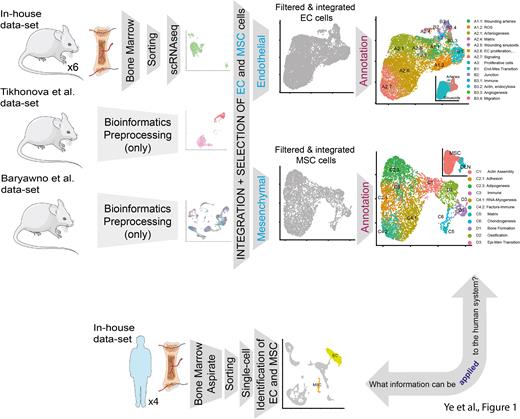Abstract
Understanding the regulation of normal and malignant human hematopoiesis requires a comprehensive cell atlas of the hematopoietic stem cell (HSC) regulatory microenvironment. Recent studies using scRNA-seq technologies have shed light on the organization of the hematopoietic regulatory microenvironment in the mouse. These studies have resolved some of the controversies regarding the overlap of stromal populations, the description of certain discrete stromal cells as professional, hematopoietic cytokine-producing populations, but also helped to delineate the relationship between specific stromal cell types in the murine BM.
Nevertheless, these studies are limited by the number of cells sequenced, potentially hampering our ability to resolve the full spectrum of cellular states and differentiation stages that define the stromal BM microenvironment. Further, knowledge on the conservation of the cellular composition in the human BM stroma is in its infancy due to the difficulty of obtaining high-quality samples with sufficient stromal cell numbers from healthy individuals. This leaves us with two outstanding challenges; how to piece together such different fragments towards a comprehensive molecular atlas and to what extent such an atlas in mice is conserved in the human bone marrow.
Here, we dissect the intrinsic organization and the heterogeneity within the endothelial (EC) and mesenchymal cell populations (MSC) governing the BM microenvironment in mouse and human. This was accomplished through customized bioinformatics integration of multiple scRNA-seq datasets along with the inclusion of over 50.000 murine and human bone marrow stromal cells. By these means, we were able to identify new subsets of MSC and EC, but more importantly, to define new molecular markers to identify highly specialized subpopulations of cells in the murine BM microenvironment. Pathway enrichment analysis unveiled multiple, potentially transient cell states defined by differential gene expression and the enrichment of specific functional characteristics. Importantly, 14 EC subsets were characterized by enrichment in pathways known to be essential for endothelial homeostasis maintenance, demonstrating a high degree of specialization in the endothelium. Similarly, 11 transient cell states in the MSC compartment were defined and characterized by their differentiation capacity. Importantly, our deep deconvolution of the heterogeneous mesenchymal and endothelial compartments became feasible only by integrating multiple datasets. Furthermore, based on the knowledge generated in the mouse, we were able to describe how much of the information and targets from the mouse can be of interest in human characterization. This analysis identified the expression of the human orthologs to the murine cluster-defining genes with different degrees of enrichment in the endothelium and mesenchyme. Moreover, some of these shared genes in mice and human stromal cells corresponded to the GO-defining genes of the different clusters identified in the mouse. These findings suggest a significant degree of conservation regarding the cellular states that define the stromal microenvironment in mouse and human. Although additional studies and improved processing of human samples will be required for deep characterization of the human BM microenvironment, these preliminary results validate our integrative cross-species approach.
Taken together, our study provides a deeper understanding of the composition and specialization of the BM microenvironment and point towards a significant degree of conservation between species. Moreover, we demonstrate the usefulness of the multi-dataset integration and the customized clustering approach used in our study to improve the resolution of complex tissues and organs. This approach promises to aid in the construction of cell atlases by reducing the resources associated with sequencing that a single lab will need to invest in order to obtain meaningful depth in single-cell analysis. Future studies integrating genome, transcriptome, epigenome, proteome, and anatomical positioning together with functional assays to correlate descriptive phenotypes with functional data will help fully resolve the composition, regulation, and connectivity in the BM microenvironment in health and disease.
Paiva: Adaptive, Amgen, Bristol-Myers Squibb-Celgene, Janssen, Kite Pharma, Sanofi and Takeda: Honoraria; Bristol-Myers Squibb-Celgene, Janssen, and Sanofi: Consultancy; Celgene, EngMab, Roche, Sanofi, Takeda: Research Funding. Saez: Magenta Therapeutics: Patents & Royalties. Prosper: BMS-Celgene: Honoraria, Research Funding; Janssen: Honoraria; Oryzon: Honoraria.


This feature is available to Subscribers Only
Sign In or Create an Account Close Modal